
Campobasso is a city and comune in southern Italy, the capital of the region of Molise and of the province of Campobasso. It is located in the high basin of the Biferno river, surrounded by Sannio and Matese mountains.

Spello is an ancient town and comune (township) of Italy, in the province of Perugia in eastern-central Umbria, on the lower southern flank of Mt. Subasio. It is 6 km (4 mi) NNW of Foligno and 10 km (6 mi) SSE of Assisi.

The province of Chieti is a province in the Abruzzo region of Italy. Its provincial capital is the city Chieti, which has a population of 50,770 inhabitants. The province has a total population of 387,649 inhabitants as of 2017 and spans an area of 2,599.58 square kilometres (1,003.70 sq mi). It is divided into 104 comuni (comune) and the provincial president is Mario Pupillo.
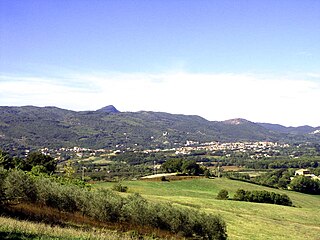
The Province of Caserta is a province in the Campania region of southern Italy. Its capital is the city of Caserta, situated about 36 kilometres (22 mi) by road north of Naples. The province has an area of 2,651.35 square kilometres (1,023.69 sq mi), and had a total population of 924,414 in 2016. The Palace of Caserta is located near to the city, a former royal residence which was constructed for the Bourbon kings of Naples. It was the largest palace and one of the largest buildings erected in Europe during the 18th century. In 1997, the palace was designated a UNESCO World Heritage Site.

Guardia Sanframondi is a town and comune in the Province of Benevento, in Campania region, in Italy. It is best known for its wine production, the wine festival Vinalia and for its Christian penitential rite held every seven years.

Ponte is the name of a town and comune in the Province of Benevento, Campania Region, Italy. It is a member of the Titerno "Local Action Group" (GAL) and its name means bridge in Italian.
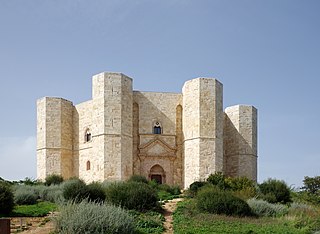
Andria is a city and comune in Apulia. It is an agricultural and service center, producing wine, olives and almonds. It is the fourth-largest municipality in the Apulia region and the largest municipality of the Province of Barletta-Andria-Trani. It is known for the 13th-century Castel del Monte.

Cosimo Fanzago was an Italian architect and sculptor, generally considered the greatest such artist of the Baroque period in Naples, Italy.

Pacentro is a comune of 1,279 inhabitants of the province of L'Aquila in Abruzzo, Italy. It is a well-preserved historic medieval village located in central Italy, several kilometers from the City of Sulmona about 170 kilometres (110 mi) east of Rome. Pacentro has been nominated as one of the "Borghi più belli d'Italia".
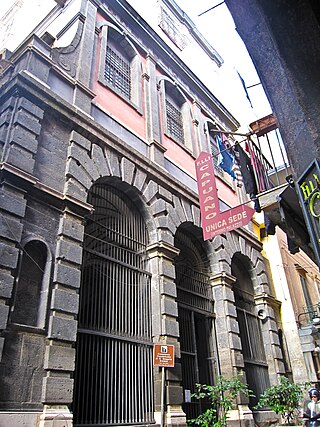
San Gregorio Armeno is a church and a monastery in Naples, Italy. It is one of the most important Baroque complexes in Naples. The church is located on a street of the same name just south of Via dei Tribunali and a few blocks south of the church of San Paolo Maggiore, Naples
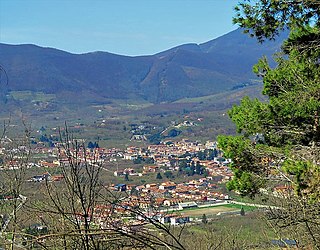
Forino is a town and comune in the province of Avellino, Campania, southern Italy.
Stigliano is a town and comune in the province of Matera, in the Basilicata region of southern Italy.
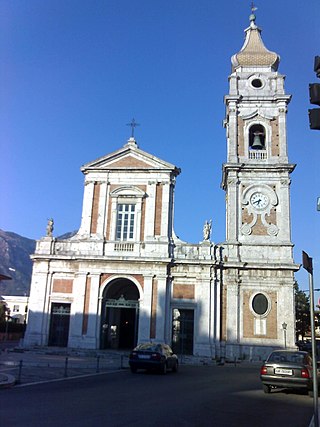
Airola is a comune (municipality) in the Province of Benevento in the Italian region Campania, located about 35 km northeast of Naples and about 20 km southwest of Benevento in the Valle Caudina, facing the Monte Taburno. Nearby is the confluence of the Tesa and Faenza streams into the Isclero River. Airola's territory is also crossed by the Acquedotto Carolino, carrying waters to the Caserta Palace.

Campolattaro is a comune (municipality) of 995 inhabitants in the Province of Benevento in the Italian region of Campania, located about 60 kilometres (37 mi) northeast of Naples and about 20 kilometers north of Benevento, its provincial capital. Bordering the municipalities of Casalduni, Circello, Fragneto l'Abate, Fragneto Monforte, Morcone, and Pontelandolfo, Campolattaro is part of the historic region of Samnium.

Morcone is a comune (municipality) in the Province of Benevento in the Italian region Campania, located about 70 km northeast of Naples and about 25 km northwest of Benevento. The villages (Contrade) of Morcone include: Canepino, Cuffiano, Coste, Torre, Fuschi, Piana.

Pietraroja is a mountain comune (municipality) in the province of Benevento in Campania, southern Italy. It is approximately 50 km by car from Benevento, in direction north-west, 83 km from Naples in direction north-east and approximately 223 km from Rome in direction south-east.

Vitulano is a comune (municipality) in the Province of Benevento in the Italian region Campania, located about 50 km northeast of Naples and about 12 km northwest of Benevento.
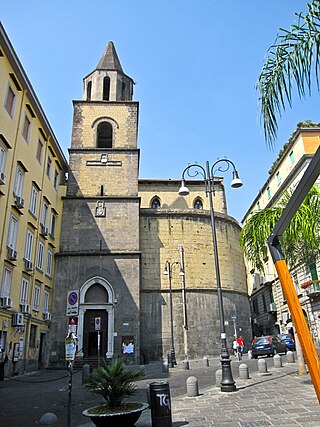
San Pietro a Majella is a church in Naples, Italy. The term may also refer to the adjacent Naples music conservatory, which occupies the premises of the monastery that used to form a single complex with the church.

Christianity and religion in general has always been an important part of the social and cultural life of Naples. It is the seat of the Archdiocese of Naples, and the Catholic faith is highly important to the people of Naples and there are hundreds of historic churches in the city. The Cathedral of Naples is the most important place of worship in the city, each year on September 19 it hosts the Miracle of Saint Januarius, the city's patron saint. In the miracle which thousands of Neapolitans flock to witness, the dried blood of Januarius is said to turn to liquid when brought close to relics said to be of his body: this is one of the most important traditions for Neapolitans.

San Francesco is a Romanesque and Gothic-style, Roman Catholic church located at Piazza San Francesco in Pescia, region of Tuscany, Italy.






















